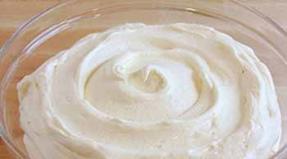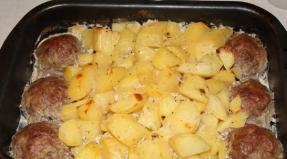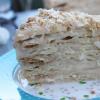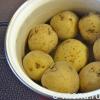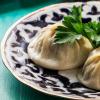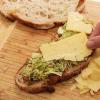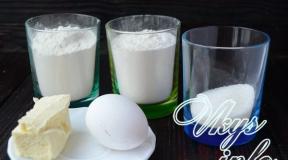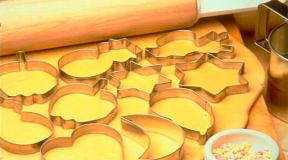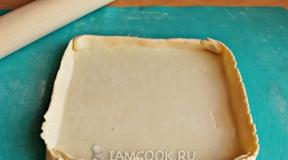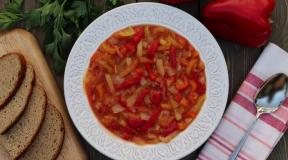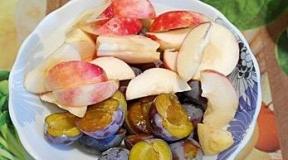How to choose a sweet and ripe melon: expert advice. The benefits and harms of the "Kolkhoznitsa" melon, features of the variety and how to choose
Roza Nurlyeva, a resident of the regional center of Saba, has been growing melons for ten years. Favorite variety - "Kolkhoznitsa". Last year I collected 27 heads from four bushes. The fruits are small - about 1.5-2 kilograms. And the taste is amazing.
“As a melon begins to ripen, its delicate aroma appears in the greenhouse. And when the garden is already filled with a fragrance, it means it's time to pick a melon for a sample. Ripe melon is all yellow, it is ready to break off the stem. But this should not be allowed - let it still mature to the end. Therefore, I “dress” them in nylon stockings and hang them up - when the melon is not lying on the ground, it ripens evenly, ”the interlocutor shares her secrets.
Rosa grows her melons on natural groundbait - no chemical fertilizers, only an infusion of chicken droppings - she usually injects it twice a season. Does not make seedlings, plants seeds directly into the soil. But not every year it is possible to get a good harvest.
“Melon is still a southern fruit, it does not grow without warmth. Last year, the seeds hatched evenly, but did not grow further. I watered with everything possible - and chicken droppings, mullein, even a biostimulant. Did not help. Everything turned yellow, I had to tear it out and throw it away. It seems that this has not happened in ten years - at the end of July they usually ate their own melon, ”says Roza Nurlyeva.
According to her, hybrid varieties of melons grow better in our conditions. But they have one feature - seeds prepared at home are not given for the next harvest year. Therefore, Rosa buys them every year.
A few tips from an experienced gardener: “The most delicious melon for us is Kolkhoznitsa. We usually buy it. We choose by smell: a ripe melon has a strong, rich, bright aroma. It can be identified by the stalk - if it is completely dry, then the melon is ripe. Pay attention to the stripes on the peel - they should be gray - the color of dust. "
"Kolkhoz woman" matures quickly
"Kolkhoz Woman" is small, round. It is the earliest of all varieties and also the most juicy and fragrant. The sweetest and juiciest melon can be recognized by the pattern on the peel - the grooves on it should stand out clearly.

"Torpedo" - oblong, grows in Uzbekistan. At home it is called "Mirzachul" melon. The correct "Torpedo" is not greenish or white, but yellow.

There are several varieties of melon under the name "Honey". They differ in shape and color. But the common feature is the perfectly smooth skin. The taste is very sweet, with hints of vanilla. A ripe melon weighs more than meets the eye.

Cantaloupe is usually dark brown or slightly lighter in color. The surface is rough, covered with a light lace mesh. There are also green stripes. The pulp is orange. Cantaloupe melon is fragrant, but its taste is rather modest. It is not very sweet and not very juicy. You can check it for ripeness by making a shallow scratch on the peel - if a green layer appears, then the melon is ripe.
How to choose a ripe melon?
The ripe fruit has a thick stem. If the melon is hard, like a stone, then it was picked ahead of time. Such a melon rings when tapped. And the ripe one will make a dull, monotonous sound.
Now you need to smell the melon. Smells like grass - so immature. Take a closer look at the stem - for a ripe melon, it should be dry. A good melon has a dense rind. If it is soft, loose, the fruit is already overripe and has begun to deteriorate. Don't buy melon along the road - exhaust fumes make them taste worse and less juicy.
Tail - dry, "nose" - soft
You need to sniff the melon at the stalk - this is its most fragrant part. Smells nothing, which means the melon is unripe. It gives off a rotten smell - it has already deteriorated. Allowed when the "nose" of the melon is softer than the rest of it.
The ball is good, the torpedo is even better
Favorite varieties of Russians - "Kolkhoznitsa" and "Torpedo". The first is good when it is small - no more than 10-15 cm in diameter. But with the "Torpedo" it is the other way around: the larger, the tastier.
Seeds - large
A fragrant, moderately soft melon was brought home, cut - to understand how ripe it is, you can be sure from the seeds. In ripe melon, they are large and easily separated from the pulp.

Are there nitrates?
The melon peel has a real accumulation of nitrates, their concentration reaches 129 mg / kg. And in the heart of the fetus there are only 40 mg / kg.
Where to store the melon?
The ideal storage temperature is 0 ... + 2 degrees. At temperatures below zero, proteins are destroyed, viscosity is lost, the frozen melon becomes unsuitable for food.
Melon benefits
Different varieties of melon have different chemical composition. Melon contains sugar, carotene, vitamins B9, C, P, provitamin A, folic acid and iron, pectin substances, oils and salts. Melon helps the digestion process, folic acid is essential for blood clotting. This product is useful during atherosclerosis, anemia, diseases of the cardiovascular system.
Vitamin C protects the body from colds and infections, early wrinkles, heart disease, improves tone.
Vitamin B soothes the nerves, makes hair thick and long, fights against dandruff and acne.
Silicon improves the skin of the body, fights against wrinkles. It also affects the activity of the brain. Needed by the nerves, intestinal walls.
Lycopene counteracts the aging process, the emergence of cancer cells.
Fiber helps the intestinal microflora. It removes cholesterol from the body, improves the digestion process.
Melon also quenches thirst, calms the nervous system. Nutritionists offer it during anemia, atherosclerosis, liver and kidney disease, cardiovascular system.
Do not consume large quantities of melon for diabetes and ulcers. It is also better for nursing mothers and babies to abstain from it. You can not drink cold water or milk, kefir after a melon, this leads to pain in the stomach. Melon is also not compatible with alcoholic beverages. Melon should not be eaten if it is scratched or cracked. It can be a source of dangerous infections such as salmonellosis and botulism.
"The stem is dry - I pick the melon"
Almira Minnullina, a resident of the village of Singel, Laishevsky district of the Republic of Tatarstan, grows both a watermelon and a melon in her garden.
“Last year and this year I sowed the variety“ Honey Fairy Tale ”. I plant directly into the soil. Now my melon is in bloom. This variety ripens in three months. Melons are small - 2-3 kilograms, but very tasty. When I buy in the store, I also pay attention to the stalk of the melon. If it is dry, then I take it, ”said Almira Minnullina.
Watermelon and melon are indispensable attributes of the outgoing summer. However, each of us has our own preferences: someone is passionate about watermelon, while others cannot live a day without the sweet aroma of melon. We have already talked about how to choose the right watermelon in one of the previous articles. How to choose the right ripe melon? Indeed, on this score, there are many wisdom and secrets.
There are a great many different types of melons, but the most popular in central Russia are the varieties "kolkhoznitsa" and "torpedo": they tolerate transportation and storage best of all. And in the homeland of this fragrant berry, the South of Russia, there is a whole range of varieties: "Galileo" with greenish and sweet pulp, cantaloupe melon with a striped skin and a bright orange heart, fragrant "Altai" melon and others.
Apart from its incredible taste, melon has a beneficial effect on the functioning of the digestive system, boosts immunity and helps to improve the skin. There is even a special melon diet that promotes rapid weight loss without the painful feeling of hunger. However, such miraculous effects are available only to those who know how to choose a ripe melon.
We will reveal a few tricks that will definitely come in handy when buying a melon:
Ripe melon aroma. The ripeness of the melon can be easily identified by its smell. Sweet and ripe melon exudes a delicate aroma. If the melon has no smell at all or, what is worse, smells of greenery, it is better to put such a fruit aside;
Melon sound correct. As with the watermelon, you can make sure the melon is ripe by lightly slapping it with your palm. A ripe melon produces a dull clap, and not a sonorous one like a watermelon;
Peel. Another little secret of how to choose a melon lies in its peel: the crust of the fruit should spring back with a little pressure. And if the melon peel turned out to be too soft, and after pressing there are fingerprints, it means that the berries are overripe and it is time for her to go to the trash heap, and not into the hands of the buyer.
Another weighty observation, which should certainly be guided by those who do not know how to choose a torpedo melon, is the color of the fruit. There should be no dark spots on the melon, the color of the fruit should be uniform regardless of the variety. Pay attention to the "tail" of the melon: it should be slightly dried. But the "nose", the trace from the flower, on the contrary, should be slightly soft.
Avoid buying melons near roads and in unsanitary tents. The fruits should not roll on the ground! In this case, they can be damaged, and pathogens of botulism or other dangerous infections can enter the melon through the cracks.
Be careful when choosing a melon to protect yourself from poisoning and enjoy this sweet and aromatic fruit to the fullest.
Summer is the time for vacations. Everyone strives to gain strength for the whole year and consume as many vitamin products as possible. Among the leaders, of course, are fruits and vegetables. Many people are very fond of tasty, juicy and aromatic melon. Therefore, they are interested in how not to be mistaken with the choice of a quality fruit. Today we will tell you where it is best to get it and how to choose the right melon.
In fact, the yellow-sided beauty is not a fruit, but a vegetable of the pumpkin family. She has many advantages, for which she is loved by the gardeners of our country. In addition to the beneficial effect on the intestines, it improves the structure of the blood, calms the nerves, and improves the normal ratio of salts in the body. Melon is a good thirst quencher.
Doctors advise using Dina as a prophylactic agent that has a diuretic, mild laxative, tonic and atherosclerotic effect. Doctors are convinced that melon contains many vitamins that help slow down the aging process, strengthen hair, invigorate the brain, and fill muscles with more energy. In doing so, it is important to follow the correct diet. This sweet vegetable is indispensable in the spring, when the immunity of each person, weakened by the hard winter, is in dire need of support.
To choose the right quality product, you should be aware of the place of purchase. Melon should not be purchased in the vicinity of the roadway. Since the presence of a large number of cars nearby causes the accumulation in the fetus for several days of a significant amount of heavy metals that come from car exhaust. 
How to choose the right melon? It is recommended to refuse to buy the fruit, on the skin of which there are obvious damage. Since they can contain causative agents of botulism, salmonellosis and other infections. It is best not to purchase already cut copies. Because you cannot be sure of the cleanliness of the knife with which it was done. It is also not advised to buy such fruits that are located on the ground, and not on pallets specially designed for these purposes. Immediately before purchasing, you need to ask the seller if he has permission to trade this product. Usually it is issued by the SES authorities. It will not be superfluous to familiarize yourself with the results of laboratory tests and the quality certificate.
Video "Sorts"
From the video you will learn about the best varieties of melons.
How to choose a sweet one?
There are proven ways on how to choose a melon, in particular, how to get a sweet one. Much in this matter depends, of course, on the variety.
For example, Kolkhoznitsa, Torpedo, Gulyabi are popular among hundreds of famous varieties of melons. 
The first is bright yellow in color, round in shape and quite aromatic. However, she cannot boast of a good degree of sweetness. You should not chase the size when buying. It is best to choose a specimen, the diameter of which will not exceed 10 - 15 cm. The torpedo has an elongated shape and large size. Moreover, the larger the fruit, the sweeter it is. She is dyed pale yellow, less aromatic and sweeter than the Kolkhoz woman. According to scientists, the Gulyabi variety appeared before our era on the territory of Central and Asia Minor.
In the days of the former Soviet Union, the Gulyabi melon was the personification of the famous oriental product. Outside, it is protected by a dense skin with a mesh of small cracks. Inside Gulyabi there is juicy, tender and very sweet pulp. The product is naturally endowed with a rich chemical composition. In addition, the Gulyabi melon is distinguished by a high degree of keeping quality and transportability.
In addition to varietal characteristics, there are ways to correctly identify a juicy melon. How Do I Pick a Good Melon? Pay attention to smell. The tasty fruit necessarily has a delicate and pleasant aroma with pineapple, honey or pear notes. If it is not there, it is better to continue searching. A fruit with a high sweetness and quite ripe can be distinguished by tapping the surface with your fingers. If you have a dull sound, you have an excellent copy in your hands. It is also necessary to examine the area of the stalk. If in this place in the process of pressing the peel bends a little, then in front of you is a ripe and juicy oriental beauty. The condition of the tail is also important. It should be thick and dry. The fruit should have a fairly tender skin. Which can then be easily removed with a knife or other sharp object. There should be a green skin underneath. 
You can not purchase a fruit on the surface of which cracks or any other damage are found. In addition to the fact that in this case there is a risk of various viruses and bacteria getting inside, it is unlikely that such a specimen will be able to please you with excellent taste. The mesh on the surface of the fruit should be dry and sandy in color. If the veins are colored green, this may indicate that the fruit is unsweetened.
How to choose a ripe one?
How to correctly identify a ripe beauty? The most excellent copies appear on the market at the end of August. Many excellent varieties are grown in the middle zone of our country. We have already talked about the most popular ones above. We also sell nutmeg melons imported from other countries. But they cannot be compared to the vegetables that are grown in the local fields. 
It is not so difficult to choose the right ripe and high-quality oriental guest, which will bring maximum benefit to the body, if you know some selection criteria. Experts do not recommend purchasing cracked and cut specimens. It is necessary to examine the condition of the tail. Dry indicates the normal ripeness of the vegetable. You should hear a dull sound after the clap. When pressing on the peel, a ripe specimen should spring a little.
Excessive hardness of the fruit will tell the consumer about its immaturity. You can not buy too soft, most likely, it will soon deteriorate and become unusable.
When fertilizing the land, chemicals such as saltpeter, urea, and sometimes even urine are often used. In order not to get poisoned, it is better to refuse to buy a specimen that has signs of excess nitrates. This is the presence of longitudinal veins, grayish and empty seeds. In nitrate fruits, the place where the tail is attached to the fruit differs in color from the rest of the specimens. It is possible to buy nitrate melon not only in June-July, but even in mid-August. Therefore, you should pay attention to the characteristic signs. 
In order for a wonderful summer fruit to delight you with excellent taste and other characteristics, you should not cut it and eat it immediately after it comes to your house. It is better to lather the surface first and rinse thoroughly with cold water. This simple procedure will make it possible to get rid of existing toxins and substances harmful to the human body, which tend to accumulate in the peel. The cut specimen should only be stored in the refrigerator. It is not advised to use the melon together with dairy products, cold water, alcoholic beverages. If you neglect these recommendations, stomach upset is possible.
Video "How to choose"
The video will show you how to choose a nitrate-free sweet melon.
Melon is not only delicious, but also very healthy if consumed correctly. Healers for a long time used the beneficial properties of melon... Avicenna treated patients with melon seeds and crusts (it was believed that with their help it was possible to cope with colds and gout), melon pulp was recommended for constipation, hemorrhoids, liver and bladder diseases. Melon calms the nervous system and improves blood formation. Modern doctors recommend melon for the prevention of atherosclerosis and cardiovascular diseases.

IMPORTANT!Melon benefits for men... Melon can surprise with some more properties. Since ancient times, she has made men real heroes. Melon seeds have been and are still used today as an aphrodisiac - a powerful aphrodisiac. To do this, you need to chew 2 grams of fresh seeds, preferably with the addition of honey, but, most importantly, do not overdo it.
The beneficial properties of a melon depend on its ripeness.... For example, insufficiently ripe fruits are not recommended for patients with stomach ulcers and acute gastritis. It is not recommended to eat melon on an empty stomach - it is considered safest to eat melon between meals so that it can mix with other foods eaten.
Melon benefits
The chemical composition of the melon depends largely on the cultivar. The pulp of the fruit contains sugar (up to 16-18 and even 20%), carotene, vitamins B9, C, P, provitamin A, a large amount of folic acid and iron (which largely determines the medicinal properties of the melon), pectin substances, fats, mineral salts ... Both the pulp and the seeds of the melon contain up to 30% fatty oil, which is quite suitable for use in food. In addition, melon has a beneficial effect on the digestion process, and folic acid is involved in hematopoiesis. Melon is very useful for atherosclerosis, anemia, cardiovascular diseases.- Vitamin C - protects the body from colds and infections, protects against early wrinkles, heart and vascular problems, accelerates the healing of small wounds, and improves vitality.
- B vitamins - soothe nerves, make hair thick and long, and help to cope with dandruff and acne.
- Silicon - improves skin condition, fights wrinkles and acne. It acts on hard tissues, on the condition of the skin and hair. Silicon has a wonderful effect on the cerebral cortex, it is needed by nerves, intestinal walls, digestive tract and the entire system of internal organs.
- Lycopene - slows down the aging process and prevents the appearance of malignant tumors.
- Fiber - from a melon has a beneficial effect on the intestinal microflora, helps to eliminate cholesterol from the body, and improves the digestion process.
Cleansing the body with melon juice
In Europe, the system of cleansing the body with the help of melon juice has recently become popular. In order to remove toxins and toxins, it is recommended to drink melon juice with any berries on an empty stomach every day for 20 days.Melon Mono Diet
This is a dietary product, and it is to this definition that melon, like watermelon, owes its low calorie content. The calorie content of a melon is 30-38 kcal, it depends on the type of melon. Melon mono-diet promotes the removal of accumulated toxins, and, moreover, is a pleasure. But you should not get carried away with such diets, because the melon has a diuretic effect, so it is not recommended to eat it for more than three days.
The benefits and harms of melon
Melon should not be carried away by people suffering from diabetes mellitus and ulcers. Likewise, breastfeeding mothers should reduce the consumption of this dessert vegetable to a minimum, as babies may develop stomach problems. After the melon, you should not drink cold water and especially sour milk, kefir and yogurt - this leads to indigestion. A similar result occurs after combining the melon with alcoholic beverages. Do not eat damaged (cracked) melon fruits, as they can lead to diseases such as botulism and salmonellosis.

What melons are there
There are several varieties of melon that differ in color and appearance. The most common type of melon is the Kuban Kolkhoz Woman, followed by the torpedo melon. Only sometimes on the shelves can you find Cantaloupe or Honey Melon - these are European varieties of melons. Choosing a ripe melon is easy enough. The main distinguishing feature is a dry stalk. Ripe domestic fruits can be identified by their sweet or honey smell. But for imports, the rule does not work. In the west, there is initially a different culture of consumption of melons. For example, in the United States, pieces of fruit are dipped in honey or sugar, so farmers initially selected unsweetened varieties.
 |
Melon Kolkhoz WomanSmall round melon. As a rule, it differs in ripeness - this variety ripens quite early and is quite capable of ripening on the way from melon to the store. This small round melon is the juiciest and most flavorful. It grows in the Volga region. Melon peel The collective farmer has a scaly, like many melons, yellow, with gray grooves. The pulp is sweet, light yellow, sometimes almost white, there may be a slight greenish tint.How to choose a melon Kolkhoz womanTo determine the juiciness of a Kolkhoz woman's melon, you need to run your hand over the melon: the grooves should stand out well. |
 |
Melon TorpedoUzbekistan long melon. At home, this melon is called Mirzachul melon. Torpedo is a rather large oblong melon. The skin of the torpedo is light yellow, covered with a "mesh", scaly, hard to the touch. The pulp is white, very sweet, juicy and aromatic. In order to fully mature, the torpedo must remain on the melon under the bright Uzbek sun. How to choose Melon TorpedoRipe melon should have yellow skins and stripes, not green. The skin emits a strong aroma. |
 |
Melon HoneyThere are several varieties of this melon, they may vary slightly in shape and color. But they all have smooth skin. Shape - variations of round and oval, but not elongated. The pulp is light, maybe with a greenish tint. It tastes a little vanilla, very sweet. How to choose honey melonRipe Honeydew melon weighs more than its size would suggest. |
 |
Melon CantaloupeThis melon from Europe and Morocco can be dark brown or slightly lighter. All covered with a rough mesh. Even green stripes sometimes appear on it. Its pulp is bright orange. The melon tastes not very sweet, not juicy, but it is very aromatic and tasty. How to choose a cantaloupe melonTo determine the degree of ripeness, you need to scratch the skin of the melon with your fingernail, if a green skin appears easily - the melon is ripe |
How to choose a melon
Necessary choose the right melon, it's not as difficult as it sounds. The stalk of a ripe melon is thick, and you can press on the rind. Unripe melon is almost stone and when tapped, the sound is ringing. And in a ripe melon, when tapped, the sound is hollow and dull. It is not recommended to buy melon off the highway, exhaust fumes diminish the benefits of the aromatic and juicy melon.
- Smell - if you smell the herbaceous aroma, the melon is not yet ripe. And keep in mind that the warmer the air temperature, the stronger the aroma is felt. Therefore, in order not to be mistaken, it is better to choose melons in a warm place.
- Clap - if the sound is dull, you have a ripe specimen in front of you.
- Look - special attention should be paid to the ponytail. If it is dry, the melon is fully ripe.
- Touch - a good melon should have a firm skin. If the skin is soft, the fruit is spoiled.
How to choose a ripe melon
"Tail" - dry, "nose" - soft
Do not hesitate to smell a melon - a ripe one should exude (especially in the "tail" area) a rich aroma. If the fruit does not smell of anything, it is unripe, if it stinks of rot, it has deteriorated. After sniffing, try to slap the melon with your palm - when it is ripe, the seeds move away from the pulp, a cavity forms inside and the fruit makes a dull sound. Then inspect the “ponytail” - it should be dry, not wet or green. It is also worth touching the opposite side for strength - the "nose" of the melon. It is desirable that it be a little soft. If it crushes too well - the fruit is overripe, if it is hard - not ripe.
A ball is good, but a torpedo is better
There are hundreds of varieties of melons in the world, but we often have to choose one of two - "collective farmer" or "torpedo". The first is bright yellow, round, aromatic, but not too sweet. If you buy it, do not seek to acquire a giant ball - good specimens are only 10-15 cm in diameter. But the "torpedo" is completely different - it is elongated, large (the larger the fruit, the tastier it is), pale yellow and compared with a "collective farmer" is sweeter, but less aromatic. Which of the two "stars" to choose, decide for yourself. If you want to taste exotic things, go to the supermarket and buy a European melon - the famous Italian cantaloupe (it is eaten with ham or Parma ham), cassaba, handalyaki or Persian. True, they are less well stored, so they rarely end up on our counters.
Seeds are large
Often, according to external signs, you can choose an ideal melon, but in fact it will turn out to be unsweetened or completely savory, so the main examination of the quality of the fruit still takes place during the tasting. The seeds of a ripe beauty should be large and easily detach from the pulp. The latter can be of different shades: for the "collective farmer" it is whitish, for the "torpedo" it is more creamy, for the "cantaloupe" it is bright orange. When you enjoy the taste of melon, do not try to gnaw it to the skin - the closer the pulp is to the skin, the more nitrates it contains. Let's say, on average, there is 40 mg / kg in the center, 71 mg / kg in the middle, and 129 mg / kg almost on the surface. If you do not finish the fruit to the end, put it in the refrigerator - a temperature of 0 - + 2 ° C is considered ideal for storing melons. At temperatures below 0 ° C, the protein molecules of the pulp disintegrate, the plasma viscosity decreases and the metabolism changes - simply put, the melon freezes and becomes inedible.
The mesh should not be green
Having studied the integrity of the skin, take a closer look at the mesh surrounding it - it should be dry and sandy in color. If the veins on the surface are greenish, this is a sure sign that the melon is immature and unsweetened. But it is not always worth paying attention to the density of the nets - for a "collective farmer", "torpedo" and "cantaloupe" this is an important indicator (the more often the veins, the better), but for the bulk of European varieties - no: they have a picture noticeable.
Scratches are acceptable
When choosing a melon, the first thing to do is to see if it is whole or not. If you notice even small cuts, punctures or cracks in the skin, it is better not to buy the fruit - through these wounds the ubiquitous harmful bacteria could easily penetrate the pulp and infect it with butulism, salmonellosis or other dangerous intestinal infection. You can forgive only small healed scratches - their "melon" GOST permits. For reasons of infectious safety, do not cut the fruit on the market or buy the fruit in slices. When there are black dots on the skin (signs of anthracosis damage) or dents, this is also fraught with unpleasant consequences - toxins begin to form in the melon pulp from the impact. However, even a fruit with a whole skin is not protected, if it is sold on the roadside or stored along with chemicals, it will still absorb harmful odors and heavy metals, will not only give off bitterness, but will also become hazardous to health.

Melon recipes - what to cook with melon
As a rule, melon is eaten fresh, as nature created it. But in addition, jam, honey, jam, marmalade, jam, compotes, candied fruits, as well as salads and snacks are made from it.Melon and ham appetizer
Parma ham should be sliced as thinly as possible so that it almost melts in your mouth. Look for the ripe melon, and wash thoroughly before cutting. Cut balls out of the melon. Wrap the melon in the ham and secure with skewers or toothpicks. Chill slightly before serving. You can drizzle a little with good olive oil and sprinkle with freshly ground black pepper.
Melon salad with grapes and chicken breast
Serve in melon halves - make zigzag cuts in the middle of the fruit with a sharp knife, split the melon in half, remove the seeds, carefully remove the pulp (about 300 g will be needed) and cut it into cubes. Boil the chicken breast in salted water and cut it together with the cheese into the same pieces as the melon. Cut the grapes into halves. Mix all the ingredients in a salad bowl, add a little salt if necessary, season with yogurt and stir.
Melon punch
-
We have already talked about how to choose the right watermelon in one of the articles. How to choose a melon? Indeed, on this score, there are many wisdom and secrets.
Melon not only has an incredible taste, but also has a beneficial effect on the digestive system, boosts immunity and helps to improve the skin.There is even a special melon that promotes rapid weight loss without the painful feeling of hunger. However, such miraculous effects are available only to those who know how to choose a melon.
Honestly, you have to try very hard to choose a melon that is not tasty during the season. But, of course, there are rules for choosing melons.
We will reveal a few tricks that will definitely come in handy when buying a melon:
Which melon is better to choose: "kolkhoz woman" or "torpedo"
There are hundreds of varieties of melons in the world. The most popular are the varieties "kolkhoznitsa" and "torpedo": they tolerate transportation and storage best of all.
The first is bright yellow, round, aromatic, but not too sweet. If you buy it, do not seek to acquire a giant ball - good specimens are only 10-15 cm in diameter. But the "torpedo" is completely different - it is elongated, large (the larger the fruit, the tastier it is), pale yellow and compared with a "collective farmer" is sweeter, but less aromatic. Which of the two "stars" to choose, decide for yourself.
Points of sale
Try not to buy melon near roads, in tents with unsanitary conditions. The fruits should not roll on the ground! Like all pumpkin vegetables, melons are good at absorbing substances from the surrounding air, harmful odors and heavy metals. The melon will not only give off bitterness, but also become dangerous to health.
The best way is to go to the market. Be careful when choosing a melon - this way you protect yourself from poisoning and can fully enjoy this sweet and aromatic fruit.
The method for determining the quality of a melon is a lot like choosing the right watermelon. But there are some peculiarities when choosing a melon. For example, a ripe melon will have a dull sound when tapped. The weight of the fruit will indicate maturity.
Try to slap a melon with your palm - when it is ripe, the seeds move away from the pulp, a cavity forms inside and the fruit emits a dull sound. A good, ripe melon sounds hollow, not loud.


Melon should not be soft to the touch, but we do not need melon as hard as iron. Usually, a ripe melon is elastic on palpation and only slightly soft in the area of \ u200b \ u200bthe nose and butt. If your finger pushes the melon too deep in these places, it means that it is overripe and should not be bought.
When choosing a melon, see if it is whole or not. If you notice even small cuts, punctures or cracks in the skin, it is better not to buy the fruit - through these wounds, bacteria could easily penetrate the pulp and infect it with butulism, salmonellosis or other dangerous intestinal infection.
The seller can pass off a cracked melon as exceptionally ripe and juicy (it burst from excess juice!). Look for a whole, flawless.
A good melon has a smooth, beautiful surface, without spots, dents or cracks. You can forgive only small healed scratches - their "melon" GOST permits.
For reasons of infectious safety, do not cut the fruit on the market or buy the fruit in slices. When there are black dots on the skin (signs of anthracosis damage) or dents, this is also fraught with unpleasant consequences - toxins begin to form in the melon pulp from the impact.
The melon should be uniform in color. Greenish streaks or spots on the skin may indicate an immaturity of the fruit. But brownish or grayish shades on the peel are a sign of the onset of spoilage - rotting.
The rind becomes softer as it ripens, so pay attention to this. If the melon is noticeably hard to the touch, it is immature, and if it is too soft, it is overripe.
Ripe melon skin is also quite easy to scratch. Try scraping the skin

melons with a fingernail: a ripe melon is easy to scratch, but an unripe melon will remain unharmed.
The color and shape of the melon can be different (the surface of the melon can be mesh or smooth, the shape is round or oblong).The size of the melon, as a rule, does not indicate anything special: there are varieties of remarkably sweet melons, the size of which is just a toy. But it is imperative to hold a melon in your hands: it should pleasantly weigh your hand (or both), be weighty.
The mesh should not be green
Having studied the integrity of the skin, take a closer look at the mesh surrounding it - it should be dry and sandy in color. If the veins on the surface are greenish, this is a sure sign that the melon is immature and unsweetened. And it is not always worth paying attention to the density of the nets - for a "collective farmer" and a "torpedo" this is an important indicator (the more veins are, the better), but for the bulk of European varieties it is not: their pattern is barely noticeable.
4. How to choose a melon by aroma
The ripeness of the melon can be easily identified by its smell. Do not hesitate to smell a melon - a ripe one should exude (especially in the "tail" area) a rich aroma.

Ripe melon smells amazing: honey, vanilla and flowers. A heavy sweet smell with notes of decay indicates that the fruit is overripe. But the melon shouldn't smell like grass!
If the melon is odorless, it means that it is not yet ripe. Some people find it uncomfortable to smell melon in public. In fact, this is completely normal, and those around you will immediately understand that you are a great specialist in melons.
5. Ponytail
Examine the ponytail - it should be dry, not damp or green. It is also worth touching the opposite side for strength - the "nose" of the melon. It is desirable that it be a little soft. If it crushes too well - the fruit is overripe, if it is hard - not ripe.
Signs of excess nitrate
Like watermelon, melon is also very often fertilized for its rapid growth. Fertilizer can, for example, with chemicals such as saltpeter, urea, and sometimes even urine. Such cultivation of the product can cause human poisoning.
The following indicators can be signs of an excess of nitrates: the presence of longitudinal veins, grayish and empty seeds. Melons grown with an overabundance of fertilizer usually do not have a rich aroma.
When you enjoy the taste of melon, do not try to gnaw it to the skin - the closer the pulp is to the skin, the more nitrates it contains. Let's say, on average, there is 40 mg / kg in the center, 71 mg / kg in the middle, and 129 mg / kg almost on the surface.
If you do not finish the fruit to the end, put it in the refrigerator - temperature 0 - + 2 ° С
considered ideal for storing melons. At temperatures below 0 ° C, the protein molecules of the pulp disintegrate, the plasma viscosity decreases and the metabolism changes - simply put, the melon freezes and becomes inedible.Ways to preserve melon
Melon lasts no worse than watermelon. And in some cases, even until spring. Of course, in this case, some of the nutrients are lost. To achieve this shelf life, the melon should be kept at 0-3 degrees Celsius. But be careful: at temperatures closer to zero, the melon will begin to freeze and lose its beneficial properties. Absolutely intact fruits are picked for preservation.
Melon pulp can be kept well dried, dried and even frozen. Only ripe and sweet melon should be selected for freezing. Fast freezing is recommended. A very popular and practical way is to use sugar syrup. Pour the cut pieces of pulp into a suitable container and place in the freezer.

